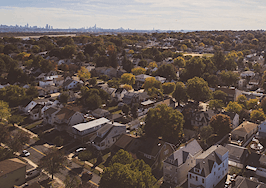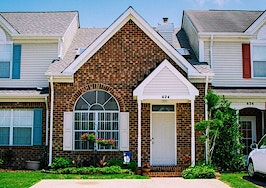The federal foreclosure moratorium ended July 31, after a fourth and final extension. The first batch of homeowners who sought protection under it will begin exiting the program later this year.
For those who will be facing foreclosure, there may be an alternative.
Consistent home price growth throughout the pandemic has created a ton of equity for homeowners across the country. According to CoreLogic’s recent Homeowner Equity Report, from the first quarter of 2020 to the first quarter of 2021, homeowners with a mortgage gained an average of $33,400 in equity.
Selma Hepp, deputy chief economist at CoreLogic, crunched the numbers even further and found that in May, the typical homeowner in forbearance had around $88,000 in home equity, excluding missed payments.
A year ago there was a lot of concern that the pandemic would trigger an onslaught of distressed sales and foreclosures, Frank Nothaft, chief economist for CoreLogic, told Inman. But now, that seems unlikely.
The National Association of Realtors (NAR) found that the median existing-home price in the U.S. hit $363,300 in June, the highest on record and the 112th month straight of year-over-year home price gains.
This newfound equity will allow some facing the possibility of foreclosure to instead list their home and use the sale price to pay off their debt.
“Homeowners could list their properties for sale as a last resort, pay off their mortgage and still come out ahead, a very different scenario from the one during the 2008 housing bust, when many lost their homes, down payments and accrued equity,” George Ratiu, senior economist at realtor.com, told Inman.
There is also expected to be an uptick in cash-for-keys deals with banks offering struggling homeowners an agreed upon sum of money to vacate their homes, New York-based attorney Elliot S. Schlissel told Inman. By doing this, the bank will be able to avoid the foreclosure process and its legal fees.

Elliot S. Schlissel.
“Instead of the bank spending $15,000 to $20,000 on their lawyers, they give it to the homeowner to move. And, it’s faster,” he said.
However, even with rising equity and cash-for-keys agreements, some homeowners may still opt for the foreclosure process, Schlissel explained, pointing to those living in areas with good schools and limited inventory.
There’s an emotional factor, he continued, that needs to be taken into account. If a homeowner has ties to a community, like having kids in its school system, they may not want to move out right away.
The ability to undergo a long foreclosure process would allow them to stay put for some time. In addition, homeowners in markets where there is limited inventory to move to may also be more likely to opt for the foreclosure route.
The delinquency rate is shrinking
Another factor holding the levee against a potential tidal wave pandemic-triggered foreclosures is the ability for homeowners to exit the forbearance program early.
According to the recent CoreLogic mortgage performance report, in April, 4.7 percent of home mortgages were in some stage of delinquency, the lowest rate since March 2020.
Per CoreLogic, the current-to-30-day transition rate measures how frequently mortgages transition from one stage of delinquency to another.
“Homeowners are catching up on their debt as the economic effects of the pandemic begin to wane, which is yet another sign of forward motion on the road to overall recovery,” Frank Martell, president and CEO of CoreLogic, said in the report.
In May, the unemployment rate fell to 5.8 percent, the lowest rate since March 2020. The recovery of pandemic-induced job loss is expected to continue putting struggling homeowners back on solid footing.

Frank Nothaft.
“We had a very good month with job creation last month,” Nothaft explained. “But we’re still way down from where we were last February and March, before the pandemic hit. We haven’t gotten all those jobs back yet.”
But if job growth continues to chug along at the same pace, he continued, the unemployment rate could drop below five percent by the end of this year, thus allowing more homeowners to make modified payment plans with their lenders.
Homes are expected to hit the market, periodically
As a result of the pandemic, low mortgage rates, slowed construction and a pull back from sellers have all contributed to a housing shortage.
For struggling homeowners exiting the forbearance period with strong home equity, they’ll have the ability to list their homes and, in theory, provide some inventory in the near term.
There will also inevitably be foreclosures.
While the monthly delinquency rate was down in March, about 2.45 million homeowners were short on payments.
The market can expect an uptick in foreclosure filings toward the end of the year and into the next, Nothaft explained, especially among homeowners with low downpayment loans.
In addition, pre-pandemic filings that were put on pause because of the moratorium will resume. It’s important, however, not to confuse the sudden increase in filings with a crisis.
Schlissel predicts that there will be a backlog of at least a year’s worth of filings in every state causing high monthly numbers in the short term. But in the long term, those numbers will dwindle.
It’s also important to note that the homes entering the foreclosure process won’t hit the market all at once.

Selma Hepp
As Hepp explained to Inman, depending on where they are located, it could take years before those foreclosed properties hit the market.
The homes that do hit the market, whether by the homeowner or through foreclosure, will provide some ease to the inventory shortage, but they won’t be enough to be the solve it.
According to NAR, U.S. housing production fell short of an estimated 5.5 million new units from 2001 to 2020 compared to 1968 to 2000. The market will need 2 million new housing units each year for the next decade to bridge that gap.













